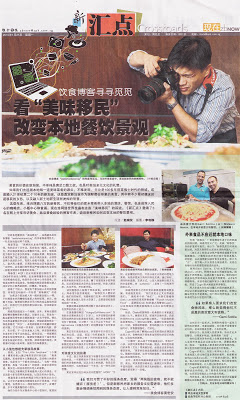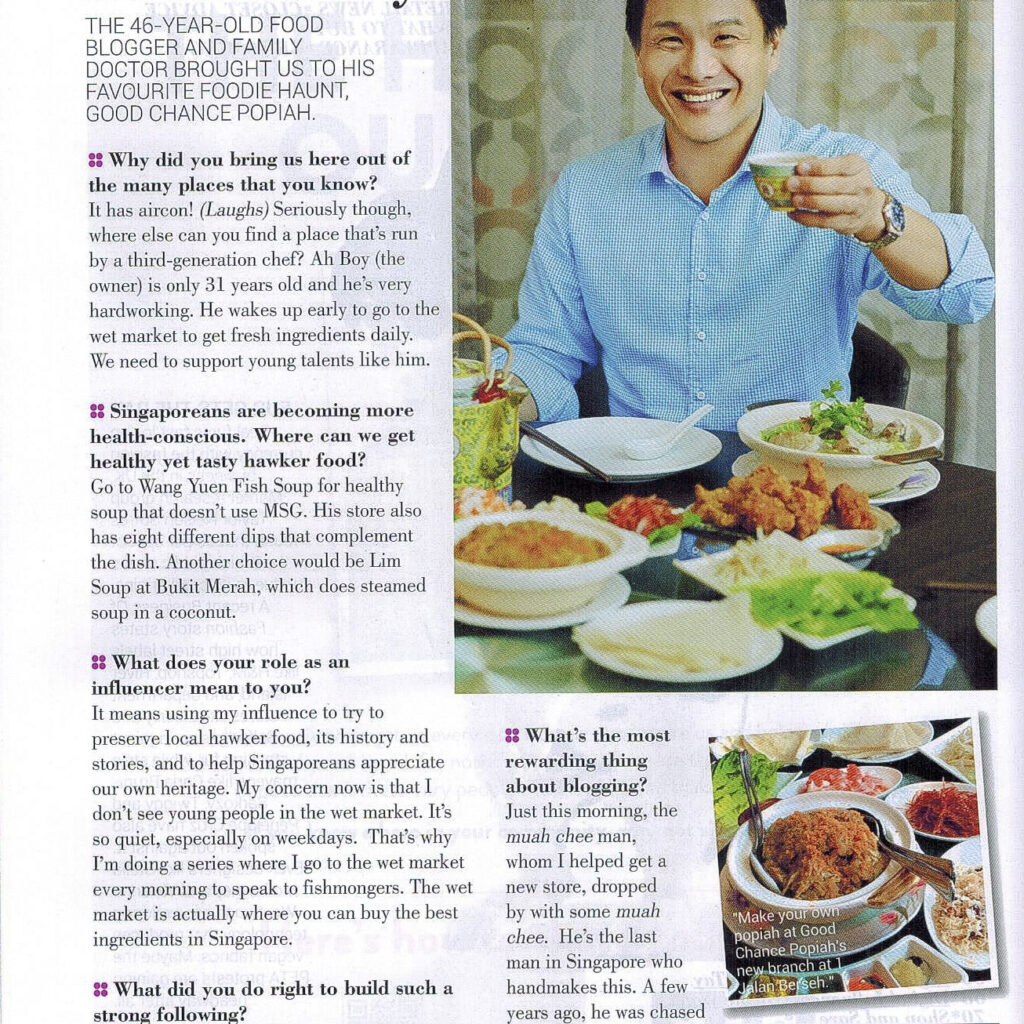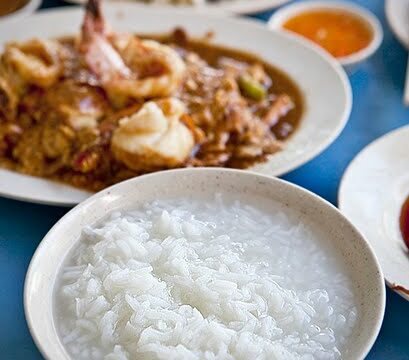It is my birthday today and I woke up not knowing that my face would appear on the front page of today’s LianHe ZaoBao!
What a wonderful surprise! I really feel that it is God’s surprise present for me!
Many thanks to all my friends who have SMSed, written in the facebook, forum and twitter! I guess nowadays it is not easy to try to hide your age!
As usual, I haven’t read the article yet because I need a translator. So I hope someone could do me the kind favour of translating this for all our readers!
Here’s the translation courtesy of Rey Chen. Thanks Rey!
When it comes to “Gourmet Migrants” , local celebrity blogger, Dr. Leslie Tay, of ieatishootipost.sg pointed out 2 strong and evident phenomenon.
According to Dr. Leslie, “The two main reasons why new migrants opened up food businesses or became chefs here stem from: 1) To earn a living 2) A love for their hometown foods. When it comes to food of foreign origins, some people may be mistaken that the most authentic & scrumptious of foreign foods can only be prepared by their own people. For instance, a Singaporean cooking Chilli Crab. In fact, locally bred professional chefs who have undergone rigorous training,too, are able to produce the same results.
Dr. Leslie Tay (aged 40) is a family doctor who went into food blogging back in 2006. He enjoys scouting around Hawker Centres and blogs about his new discoveries. Just like most Singaporeans, his favourite foods are Oyster Omelette, Char Kway Teow, Prawn Mee etc.
He raised an example to support his views on “Gourmet Migrants”, at a time when no Singaporean has ever opened eateries abroad – If this person, a typical Singaporean who has had his fair share of home-cooked and hawker foods, is overseas and introduces his/her foreign friends to our local delicacies and calls it Singaporean Food. Just imagine how tasty it’d be.
Dr. Tay noticed another trend in recent years. With the growing numbers of steamboat/hotpot restaurants sprouting everywhere on the island, to call this a hotpot wave led by the new migrants is not an exaggeration. Dr. Tay believes that these restaurants are targeting the “new migrants” in mind, and not the locals. This is reinforced by the wide use of animal innards, necks & tongues, which may not suit our locals’ tastes. In other words, when new migrants bring “flavours of their hometown” to a foreign land, it’s likely that the initial concept is to satiate the taste buds of the fellow migrants. Dr. Tay feels that the more authentic the food, the longer it will take to be accepted by unfamiliar patrons.
Reliving stories of our Forefathers from Xiao Long Bao.
“Food knows no boundaries” is something Blogger Ju of “The little Teochew” swears by. Food has the ability to unite people. Trying out different cultural food is the first step to understand different cultures.
Ban Mian is one Northern China dish introduced here 10years back and has now become a local favourite. The latest Northern China dish that’s selling like hot cakes would be the XLB.
Leslie Tay has blogged on many XLB eateries, acknowledging the fact that it’s gradually becoming a commonner fare. It’s possible to find good 10 for $5 XLB even in a food centre these days, comparable to restaurants standards.
Leslie was reminded of his granddad’s story, when he was giving an explanation on XLB at Chinatown Food Centre. This stall, which specializes in Northern China cuisine, seems to be reliving the stories of early migrants. Their aim is to earn a living here so as to support their family back home. Some of them would bring their families over when they get used to the life here.
Leslie shows admiration for these migrants as they show tenacity and perseverance as compared to our younger generations – they expect things to be done easily owing to their comfortable lifestyle.
Hungrygowhere.com spokesperson ,Huang Hong An, observed that new migrants (from restaurant owners to waitresses) have made significant impacts on our culinary scene. They are able to provide quality service, even for a $2 bowl of noodles. When they bring their foods over, they too bring along quality service which allows consumers to feel at ease.
However the one thing about the migrants (aside from food) that impressed Gourmets, is their persistence towards food culture. Through their passion and persistence, foodies are able to experience different cultures while tasting the food.
Ivory, located in Clarke Quay, was pointed out by Huang Hong An for example. This restaurant doesn’t differentiate Northern and Southern Indian Cuisine but rather, specializes in iconic Southern Indian Coastal cooking style. This way, it not only adds colours and diversity to Indian Cuisine. It broadens our knowledge to what “Authentic” really means.
When Leslie spoke on food places which left him in great appreciation, he said “They are showcasing their culture to us.” without a second thought. “They” are Ridyadh Muslim Food @ Defu Lane, Cugini @ Club St and Chako @ West Coast Hong Leong Garden.
The Chef who helmed Chako is a classic, unpretentious Japanese housewife. She enjoys cooking and believes in “good food comes with patience”, despite having to run a business. This is often heard during peak hours when the restaurant is full-house. Upon arrival of the food, she would regularly remind patrons to have their meals slowly.
On the other hand, Cugini made Leslie realize there is no such thing as thin/thick crust pizza. The originality lies with the Chef’s passion towards experimenting and also the freshness of the ingredients.
Ju of “Little Teochew” is a full-time housewife with 3 children to take care of and Blogging is her passion. She hinted that when migrants bring their food culture over, this culinary wave would definite reshape our local culinary scene. And as time goes by, all these foreign influences would eventually become part of our Singaporean food.
In recent years, more and more eateries specializing in specific cuisine have sprung up throughout the island. This is a piece of good news to foodies. On top of providing a wider variety to choose from, new migrants help in refining food cultures, pushing Singapore culinary scene to a higher level.













